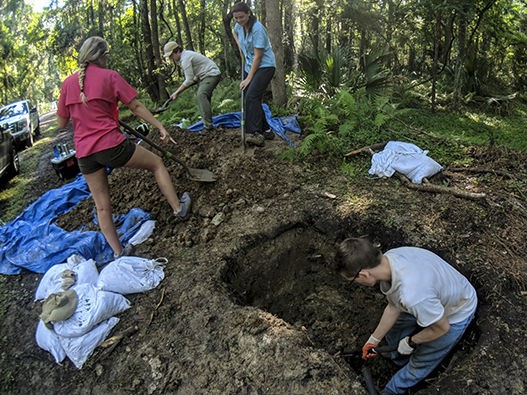"It was an eye-opening experience," said Allen, who had been on a previous fossil expedition in Africa where, unlike this trip, she found and collected hundreds of specimens. "My favorite part was seeing how dedicated everyone was to get out and dig these holes."
Funded through a UNG Presidential Incentive Award, the trip in late May and early June yielded only a few marine fossils such as stingray teeth and small bone fragments, said Dr. David Patterson, assistant professor of biology at UNG.
"We collected those and sent them to Georgia College & State University in Milledgeville, Georgia," he said.
Patterson explained GCSU will house the fossils and its students will collaborate with UNG students to create a Coastal Georgia Fossil Database, which will feature new and existing fossil collections.
The holes that UNG students dug in the mosquito-infested land did not produce any fossils, but that didn't stop their enthusiasm.
"No one was complaining," said Allen, who graduated in May 2018 with a bachelor's degree in biology and is from Cleveland. "No one was in a bad mood."
The fieldwork did provide plenty of data to examine and analyze.
"Now that we understand the geology of the area better, we have a better idea of where the fossils are and the area where we can find them," Patterson said. "Next time, we can really concentrate on these specific places."
Providing the geological information was Dr. Christopher Seminack and two of his students with the assistance of ground-penetrating radar. Essentially, the device takes an X-ray of the ground and shows the different layers of the earth, including potential areas for fossil deposits.
Seminack, assistant professor of geology at UNG, used the device earlier in May for his own research trip on Sapelo Island, about 33 miles northeast of Brunswick. On the island, Seminack and a couple of students looked for erosion from past storms and eroded layers of the beach.
"We can get a better understanding of how past storms affected the barrier islands and what we can expect in the future," he said.
Seminack and his students also collected sediment samples to analyze at UNG. Once the undergraduate students complete the study, they can write a thesis and present it at a geological conference.
Supplying students with fieldwork and its accompanying research is a goal of Seminack and Patterson's trips.
"The fieldwork gives them an appreciation of how much effort it takes to collect the data and analyze it," Seminack said. "It really opens their eyes."
Patterson said it’s a great way to train students to ask questions and search for the answers.
"The purpose of the project is to find fossils and better understand the animals that lived in the region 20,000 years ago," he said. "We can find out why they went extinct and how they are different from animals on earth today."
Both faculty members hope the data collected will lead to future research trips and outside funding and grants.

http://accesswdun.com/article/2018/7/686342/working-white-county-woman-among-ung-group-searching-for-fossils-on-ga-coast
